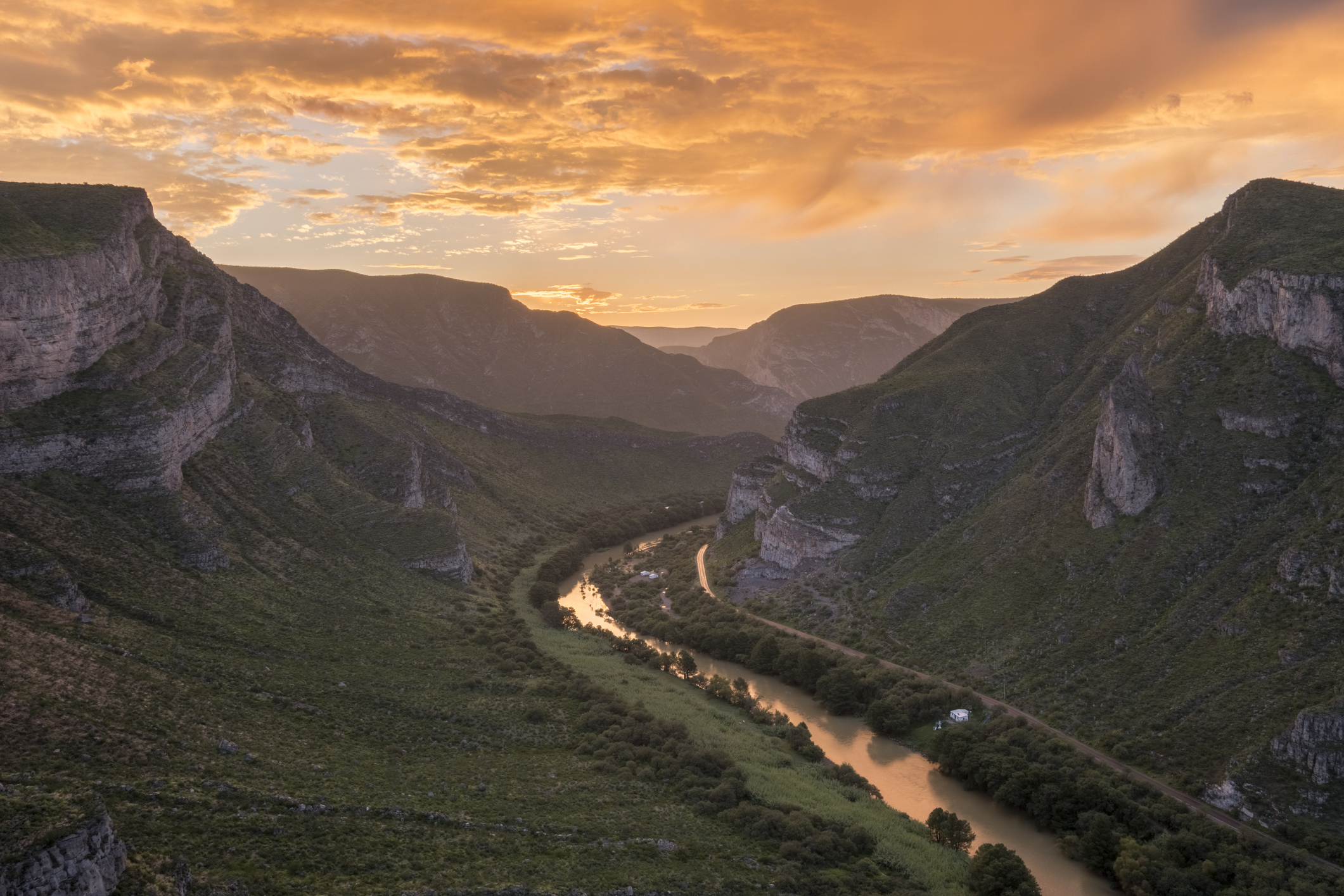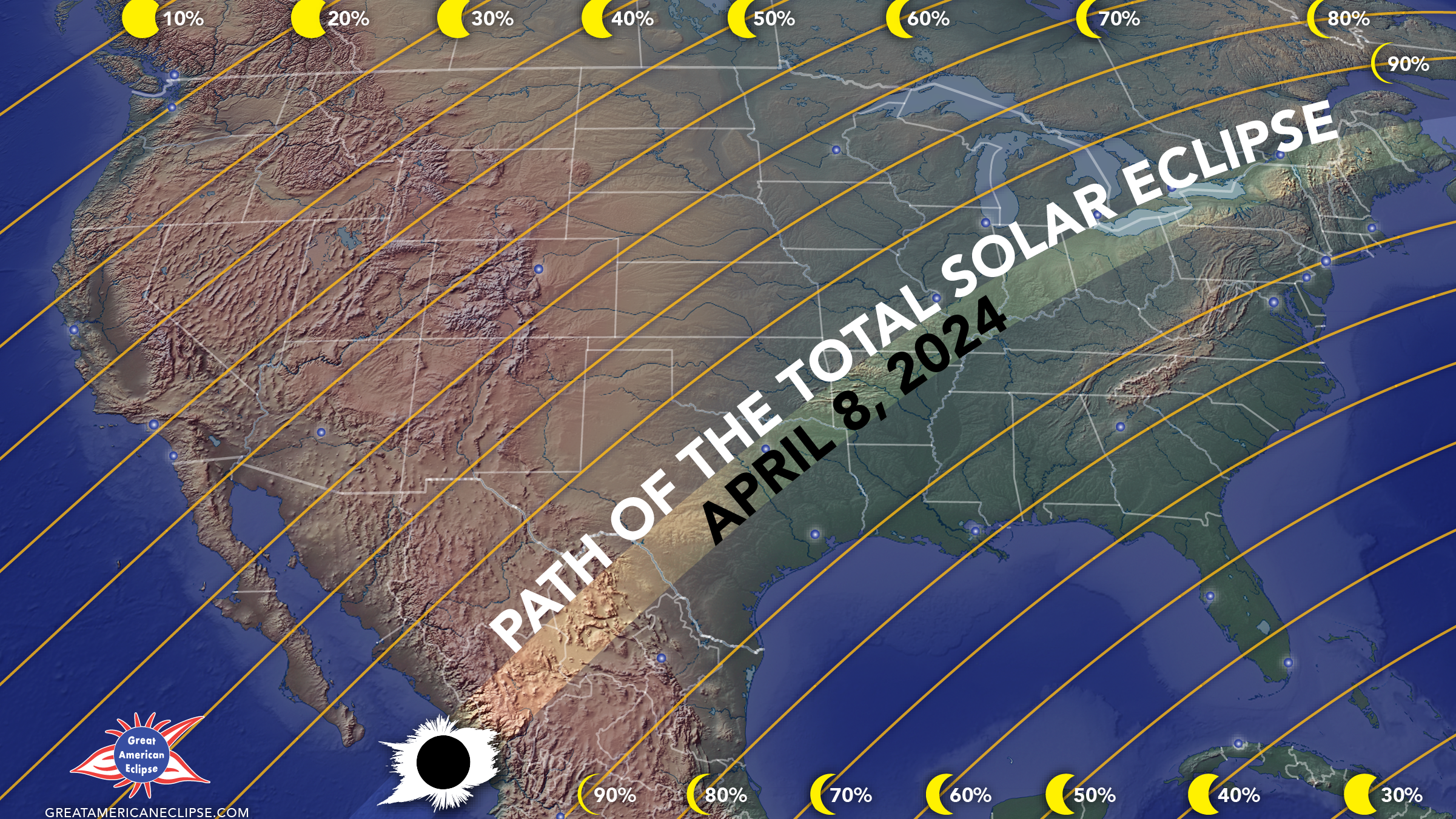Where is the best place to see the April 2024 total solar eclipse?
On April 8, a total solar eclipse will be visible across North America.

Witnessing a total solar eclipse is a rare opportunity — after next year's event, on April 8, 2024, the next chance to see a total solar eclipse in North America won't occur for more than 20 years. Naturally, being in the right place at the right time is crucial.
So where's the best place to see the total solar eclipse 2024?
While you can watch the total solar eclipse live here on Space.com and keep up with all the actions with our total solar eclipse 2024 live updates blog, nothing quite beats watching an eclipse in person.
First, you'll have to be within the narrow path of totality to see a full total solar eclipse, in which the moon completely covers the sun's face from our point of view on Earth. This path is just 115 miles (185 kilometers) wide, and on land, it stretches over 4,000 miles (6,400 km) from Mazatlán in western Mexico to South Bird Island in Newfoundland, Canada.
Related: Where will the April 2024 total solar eclipse be visible from?
Totality will first be visible in Mexico, where Sinaloa, Durango, Chihuahua and Coahuila will go under the moon's central shadow. It will then cross parts of 15 U.S. states: Texas, Oklahoma, Arkansas, Missouri, Illinois, Kentucky, Tennessee, Michigan, Indiana, Ohio, Pennsylvania, New York, Vermont, New Hampshire and Maine. Parts of the Canadian provinces Ontario, Quebec, New Brunswick, Prince Edward Island, Nova Scotia and Newfoundland will also experience totality.
REMEMBER to NEVER look at the sun directly. To safely view this solar eclipse you must use solar filters at all times. Only during the exact moment of totality, when the sun's disk is 100% blocked by the moon can you look with the naked eye. This is possible only within the path of totality, and only for a few minutes depending on your location within the path. At all other times, precautions must be taken. Observers will need to wear certified solar eclipse glasses, and cameras, telescopes and binoculars must have solar filters placed in front of their lenses. For more information on solar viewing safety check out our how to observe the sun safely guide.
Breaking space news, the latest updates on rocket launches, skywatching events and more!
The point of greatest eclipse
Although not everyone agrees on the best place to experience a total solar eclipse, most dedicated eclipse chasers head to the so-called point of greatest eclipse, weather permitting. This is the place that experiences the longest duration of totality. For the April 8, 2024, eclipse, totality at the point of greatest eclipse will last 4 minutes, 28 seconds — the longest duration of totality on land since 2010.
On April 8, the point of greatest eclipse will be just north of Nazas, Mexico, which has a population of about 4,000 people. The area is arid and typically has mild and dry winters; in fact, Nazas has the highest statistical chance of clear skies within the path of totality.
So, a no-brainer, right? Not on this occasion. This eclipse's magnitude — meaning the relative size of the moon to the sun — is such that totality varies only over huge distances. For example, to the southwest, close to Mazatlán, it will be possible to experience 4 minutes, 26 seconds of totality, while on the Mexico-U.S. border at Radar Base, Texas, totality will also last 4 minutes, 26 seconds. Will eclipse chasers, particularly in the U.S., travel to a remote part of Mexico to experience an extra two seconds of totality? Almost certainly not.
The longest duration of totality in the U.S.
Texas will get a lot of attention on April 8. Not only does it have the highest chance of clear skies for anywhere within the path of totality in the U.S. around that time of the year, but the geometry of the eclipse also means it will host the longest totality in the country.
The center of the moon's umbral shadow will enter Texas from Mexico at the town of Radar Base at 1:27 p.m. local time, with totality lasting 4 minutes, and 26 seconds there. It will exit Texas at the Bryarly Cut-Off on the Red River, the border with Oklahoma, at 1:49 p.m. local time, where totality will last 4 minutes, 19 seconds.
The path of totality will include major cities in Texas. Of them, Dallas will experience the longest duration of totality at 3 minutes, 49 seconds. The center of Austin sits just within the path (the Texas State Capitol building will get 1 minute, 49 seconds), while only the northwestern suburbs of San Antonio are in the path (experiencing between a few seconds and 2 minutes totality). The easiest way to check if a location will be in the path of totality (and the duration of that totality) is by using Xavier Jubier's interactive Google Map of the eclipse.
The longest duration of totality in Canada
It's not a good idea to cross international borders on the day of an eclipse. The waiting times could make you miss the eclipse and the geography of the U.S.-Canada border around the Great Lakes region makes it impractical. So, if you plan to watch the eclipse in Canada, it's helpful to know where to maximize your experience.
Pelee Island and the region around the shore of Lake Erie are the first to fall under the moon's umbra, at 3:12 p.m. local time, for 3 minutes, 7 seconds of totality. However, the centerline of the path of totality — where totality lasts the longest — first strikes Canada at 3:26 p.m. in Quebec's Eastern Townships south of Sherbrooke, along the U.S. border, where totality will last as long as 3 minutes, 32 seconds.
Only the southern half of Montreal Island is within the path of totality, with the duration of totality longest in the south of the city, where it reaches just shy of 2 minutes.
The best chances of a clear sky
It doesn't make any difference how long totality will last in your intended location if clouds block your view of the eclipse. Sure, it will still get dark during totality — much darker than if it's clear, in fact — but that won't be your goal. Because a few seconds of clear totality are better than a long duration of cloudy totality, weather is more important than the duration of totality.
That's weather, not climate. There are some excellent detailed analyses of the climatology of the eclipse track, such as meteorologist Jay Anderson's report on Eclipsophile. In it, he highlights that the winter dry season will be ending in Mexico, the U.S. could experience a mix of thunderstorms and even snowfalls, and the Canadian Maritimes will still be frozen. He also points out that storms are common in the Midwest in April, which could affect the path of totality in northeastern Arkansas, Missouri, Illinois, Indiana and Ohio.
However, all of this is based on historical data, which describes the average climate for long-range planning and doesn't give you any information on what the weather will actually be like on eclipse day. The only way to locate a clear spot that day is to closely follow local weather forecasts the week before the eclipse — and be prepared to drive a few hundred miles in the day or two before the event.
"Preparation and mobility will be important contributors to your success," Anderson wrote. Is experiencing totality worth studying weather forecasts, driving a few hours and sleeping in your car for one night? Yes, absolutely. For most dedicated eclipse chasers, that's usually the plan.
Related: How El Niño may affect the chances of clear skies for the 2024 total solar eclipse
The best places to be an eclipse chaser
For the best chance for clear skies shortly before totality (though you should check for cloud cover at least 24 hours beforehand), choose a location with major highways and interstates within the path of totality. That might seem simple, but many of these roads snake in and out of the path. The highlight is Interstate 90, which could take eclipse chasers on a path through Toledo and Cleveland, Ohio, to Erie, Buffalo, Rochester and Syracuse, New York — a distance of roughly 450 miles (720 kilometers) — without ever leaving the path of totality.
Here are some other good options:
- Interstate 10 between San Antonio and Junction, Texas
- Interstate 35 between San Antonio and Dallas
- Interstate 64 between St. Louis, Missouri, and Louisville, Kentucky
The best places to photograph the eclipse
Again, this is also about where the sky will be clear, but there are some other considerations. If you want to capture the eclipse close up, this is irrelevant — but the altitude of the sun will matter hugely if you would rather capture wide-angle images of the eclipse in the context of a landscape image.
At Mazatlán, the eclipse will occur at 11:07 a.m. local time while 69 degrees above the southeastern horizon, which is way too high for landscape images. The same goes for Texas, where the eclipse will be at 68 degrees and will fall to 63 degrees. The eclipse will occur later in the day, and thus be lower in the sky, the more the path of totality tracks to the northeast. As totality departs North America at Newfoundland at 5:13 p.m. local time, the sun and moon will be just 23 degrees above the western horizon. The presumed worst place to be, climate-wise, could herald the most dramatic images on eclipse day — or none at all.
Our how to photograph a solar eclipse guide can help you plan the perfect shot and if you're looking for equipment we have several buying guides including best cameras and best binoculars.

Jamie is an experienced science, technology and travel journalist and stargazer who writes about exploring the night sky, solar and lunar eclipses, moon-gazing, astro-travel, astronomy and space exploration. He is the editor of WhenIsTheNextEclipse.com and author of A Stargazing Program For Beginners, and is a senior contributor at Forbes. His special skill is turning tech-babble into plain English.


